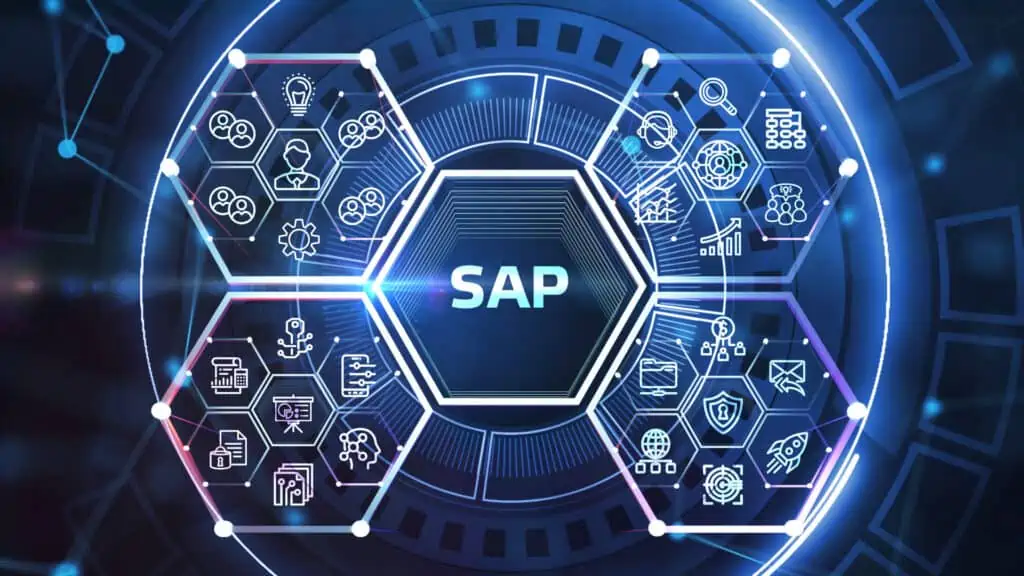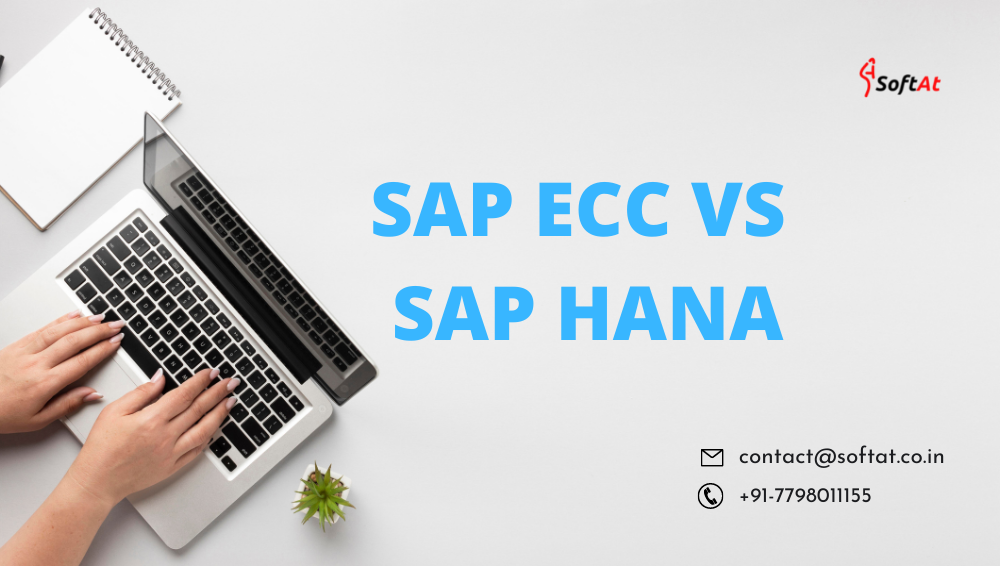SAP is a global German company that has been developing enterprise software to manage various corporate activities and customer relationships since 1972. It is particularly well-known for its Enterprise Resource Planning (ERP) software, which is used by businesses all over the world. R/1, R/2, R/3, ECC, and S/4 HANA are the many SAP ERP software products that have been made available over time. ECC ERP is currently the most widely used SAP ERP software. Now let’s compare SAP ECC VS SAP HANA.

What does SAPECC stand for?
SAP ECC is a significant technology in business and virtually every other industry. It has existed since its inception as a financial software solution. RF was the actual name for it. SAP ECC stands for SAP ERP, which is the first business application suite. The software package has grown over time to include additional modules such as RM/1. Within a few years following its release, the suite was renamed R/1.
R/2 was first released in 1979. The program incorporated a variety of business operations. It is used in a variety of industries, including logistics and supply chain management, human resources, manufacturing, and accounting. This version became the most widely used client/server technology that did not require mainframes. R/3 was compatible with a wide range of databases and computer systems.
What does SAP HANA stand for?
SAP Business Suite 4 SAP HANA is also known as SAP S/4 HANA. It is SAP’s most recent ERP offering, and it’s built on the HANA in-memory database to allow businesses to conduct transactions and analyze data in real time. It is the SAP Business Suite’s fourth edition, and it is designed to run only on HANA.
S/4HANA helps enterprises run easier, quicker, and more efficiently with a Fiori-powered user experience, incorporating real-time analytics, and HANA-powered in-memory processing to handle enormous data volumes of operational and transactional business data. Furthermore, S/4 HANA eliminates batch delay, manual processes, and data sprawl, all of which are issues with traditional ERP systems.
Similarities
The two ERP systems share a variety of commonalities.
Sales, procurement, manufacturing, distribution, service, quality, accounting operations, and facility maintenance are all supported by both ECC and S/4 HANA. Both systems provide a centralized database for a company’s operational data, as well as standardization and automation of common processes and a single source for operational reporting. Both ECC and S/4 HANA are modular systems, allowing businesses to employ the elements they already have configured in a way that makes sense for their needs.
Almost all of the basic capabilities and functions of S/4 HANA and ECC are likely to be shared. There will, however, be differences and benefits that companies might gain as a result of technology developments.
Differences in ERP systems
- Database: ECC can run on third-party databases like Oracle, MaxDB, and IBM. S/4 HANA can only run-on HANA, an in-memory modern technology.
- Customer vs Vendor to Business Partner: Even when a firm works with another corporation for both functions, ECC maintains distinct customer and vendor files. A Business Partner record in S/4 HANA combines common arrangement elements.
- Merger of Controlling (CO) and Finance (FI): FI GL accounts are mapped to CO primary cost elements in ECC. Both the GL account and the price element are stored in S/4 HANA using the universal journal structure.
- New General Ledger (GL): SAP ECC can use either a “classic” or a “modern” GL structure to execute. Only the new GL is used in S/4 HANA, which is technically quite comparable to the new GL in ECC. However, in S/4 HANA, the new GL capabilities is necessary, and it may be a requirement for brand new asset accounting.
- Rebates: Consumer rebates through existing SD rebate processing in ECC are replaced by settlement management through condition contracts in S/4 HANA.
One of the most significant differences between SAP ECC vs SAP HANA is that the architecture modifications have given enterprises new methods to deal with the data they collect. It merged accounting ledgers into a single universal record from a financial standpoint. This move will make it easier for a company’s financial department to undertake profitability analyses.
The introduction of SAP HANA resulted in a number of significant changes to the functional scope. The consolidation of the two general ledger architectures was one of the most significant advancements. As a part of the SAP HANA migration, the new accounting architecture was automatically installed.
SAP HANA introduced a slew of functional improvements that made it a worthwhile upgrade from SAP ECC. While compatibility packs exist to allow ECC functions to run on HANA, they will not perform optimally. To obtain the best return on investment and use out of SAP HANA, existing ECC users need to grasp all the functional changes and weigh up the merits of each system.
Benefits of S/4HANA over ECC
In comparison to earlier ERPs, such as SAP ECC, SAP S/4HANA offers substantial advantages. As a result, it’s no surprise that SAP opted to stop supporting older ERPs in 2027 because SAP S/4HANA’s ERP system benefits make it a far more advanced platform. Let’s have a look at the important benefits.
Boost Your Performance
SAP’s newest ERP platform, with its underlying SAP HANA database technology, allows real-time data insights and overall faster access to your full data volume. This enables you to do big data analysis, which aids in corporate-wide planning, flexible decision-making, and the quick completion of complex transactions.
Simplify Your Processes
One of the benefits of SAP ERP is that it allows you to rearrange your IT environment in a more visible and centralized manner. Because of automation possibilities, your entire workflow and all associated business activities operate more efficiently and are much easier to manage after an integration. As a result, SAP S/4HANA will help all of your company’s departments.
Innovate Your Business
SAP S/4HANA and forward-looking technologies go hand in hand which makes your workflow more efficient. State-of-the-art innovations such as Artificial Intelligence, Machine Learning, the Internet of Things, or Robotic Process Automation can be smoothly integrated into the platform. These solutions keep your business productive and make your company ready for the future.
Extend Your Flexibility
One of the most significant advantages of SAP S/4HANA over ECC is that it provides you with a variety of deployment options. Choose whether to run SAP S/4HANA on-premises or on a public, private, or hybrid cloud. Giving your company’s data resources worldwide access is what makes it genuinely flexible and adaptable.
Improve Your User Experience
Another significant advantage of SAP S/4HANA is that the platform is more user-friendly. You get an easy and customized user experience with SAP Fiori that always gives you clear insights into all of your corporate data and transactions. It’s never been easier to keep track of everything!
Save Your Resources
All of SAP S/4HANA’s ERP system advantages can be summed up in one key benefit for businesses: cost savings. Because the strong and centralized ERP system requires less hardware and maintenance work, you gain important financial resources that you can re-invest in the growth of your business.
Real-Time MRP (Material Requirement Planning)
To complete material requirement planning, SAP ECC requires batch jobs to be run during non-peak hours (MRP). SAP S/4HANA alters the game. Batch jobs are unnecessary because MRP can be run in real-time. In addition, in SAP S/4HANA, MRP with subcontracting has been simplified. It is important to note that MRP can be executed at the plant and MRP area level only. It cannot be run on the storage level.
The key business benefits of moving to SAP S/4HANA
- Simplification of business processes to drive them in real-time by eliminating background jobs and aggregate tables
- Improved performance planning, execution, report generation, and analytics based on live business data
- Triggered period closing and improved business predictions
- Simplification of the entire IT landscape
- The reduced total cost of ownership
- Ability to work on large data sets in one system – thus saving hardware costs, operational costs, and time
- Innovation with the help of an open platform to drive advanced applications which can help to predict, simulate, and recommend business operations while also safeguarding existing investments
- Rethinking, reengineering, and reinventing business processes
- Faster decision-making with real-time insights into business data
SAP GUI vs. Fiori
Fiori is a new, visual user interface for SAP that differs from the traditional linear, menu-driven SAP GUI. It provides the kind of straightforward, consumer-level user experience that most office workers today anticipate. Fiori is a new mobile capability that is streamlined and familiar to users of mobile apps. Fiori allows users to engage with SAP apps on a variety of devices from any location.
SAP Fiori benefits over SAP GUI
Fiori has a number of advantages over SAP GUI. These benefits include higher productivity as a result of faster task completion. While the SAP GUI requires you to go through a series of menus in order to accomplish anything, Fiori is more touch-based. Users can begin tasks on one device and finish them on another.
Will SAP Fiori Replace SAP GUI?
Fiori is unquestionably on its way to replacing SAP GUI. This is particularly true for companies transitioning from previous SAP versions to SAP HANA and S/4 HANA. It’s worth noting, though, that not all SAP companies are ready or interested in making the conversion. There are a number of reasons for this hesitation to embrace Fiori. For one thing, some businesses have spent a significant amount of effort customizing SAP GUIs. They might not want to spend the money and time necessary to replace them.SAP ECC VS SAP HANA
conclusion of SAP ECC VS SAP HANA
In conclusion, while SAP ECC has served as a reliable ERP solution for many organizations, SAP HANA brings unprecedented speed, agility, and insights to the table. It empowers businesses to leverage real-time data for better decision-making, gain a competitive edge, and adapt to rapidly changing market dynamics. As technology continues to advance, embracing SAP HANA becomes a strategic move that paves the way for digital transformation and positions organizations for success in the data-driven era.
sap ecc vs hana





